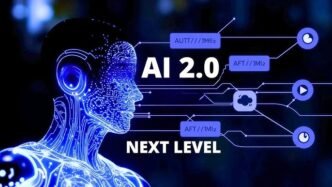Breaking barriers in mathematics, coding, and STEM fields with unprecedented reasoning capabilities
The world of artificial intelligence is witnessing a groundbreaking development as OpenAI unveils its latest model, o1. This new AI model surpasses previous language models by demonstrating exceptional reasoning skills, marking a significant leap forward in complex problem-solving across various domains like physics, coding, and advanced mathematics.
While previous models like GPT-4o excelled in language-driven tasks such as writing and editing, they often struggled with the intricate reasoning required for advanced STEM applications. OpenAI’s o1 addresses this gap, potentially revolutionizing how AI assists in scientific research, engineering, and technology development.
A Quantum Leap Beyond GPT-4o
Overcoming Previous Limitations
GPT-4o, OpenAI’s leading model before o1, was renowned for its proficiency in language tasks. However, when it came to complex reasoning, it faced significant challenges. For instance, in tasks that required following strict constraints or performing multistep calculations, GPT-4o often failed to deliver accurate results.
An anecdotal example illustrates this limitation: when tasked with creating a poem that adhered to specific letter usage constraints, GPT-4o repeatedly produced poems that didn’t meet the requirements. Despite recognizing its mistakes upon review, it was unable to generate a correct version within the constraints, highlighting its shortcomings in reasoning and problem-solving.
The Chain-of-Thought Technique
OpenAI’s o1 introduces a novel approach known as the “chain-of-thought” technique. This method allows the model to:
• Recognize and Correct Mistakes: o1 can identify errors in its reasoning process and adjust accordingly, leading to more accurate outcomes.
• Break Down Complex Problems: It deconstructs intricate tasks into simpler, manageable steps, mirroring human problem-solving strategies.
• Adapt Alternative Approaches: When a particular method isn’t yielding results, o1 can switch tactics, showcasing flexibility in its reasoning.
This advancement enables o1 to tackle challenges that were previously beyond the capabilities of AI language models.
Exceptional Performance in Competitive Domains
Stellar Results in Coding Competitions
In the realm of programming, o1 has demonstrated remarkable prowess:
• 89th Percentile on Codeforces: Codeforces is a renowned platform for competitive coding, where participants solve complex algorithmic problems under time constraints. o1’s performance places it among the top coders globally.
• Enhanced Coding Abilities: The model excels in understanding programming languages, debugging code, and generating efficient algorithms, making it a valuable tool for developers.
Mastery in Advanced Mathematics
OpenAI’s o1 has also showcased exceptional skills in mathematics:
• Top 500 in USA Math Olympiad: The model’s proficiency in topics such as geometry, number theory, and combinatorics places it alongside some of the brightest high school mathematicians in the United States.
• 83.3% Accuracy on Math Olympiad Questions: This is a significant improvement compared to GPT-4o’s 13.4% accuracy, indicating a substantial leap in mathematical reasoning.
Outperforming Human Experts in PhD-Level Questions
In evaluations involving PhD-level questions across subjects like astrophysics and organic chemistry:
• 78% Accuracy Achieved by o1: This surpasses the average accuracy of human experts, which stands at 69.7%.
• GPT-4o’s Performance: The previous model had an accuracy of 56.1%, highlighting the considerable advancements made with o1.
These statistics underscore o1’s potential to contribute meaningfully to advanced research and problem-solving.
Why o1 Matters: Bridging the Gap in AI Capabilities
Transforming STEM Fields
The bulk of progress in large language models has been predominantly language-focused. However, many critical areas, such as drug discovery, materials science, and physics, require robust reasoning abilities. OpenAI’s o1 is poised to bridge this gap, offering:
• Enhanced Problem-Solving: With its advanced reasoning, o1 can tackle complex equations, simulate experiments, and analyze data more effectively.
• Accelerated Innovation: By assisting researchers in processing and interpreting vast amounts of information, o1 could expedite breakthroughs in various scientific fields.
Mimicking Human Thought Processes
o1’s ability to break down problems and learn from mistakes mirrors human cognitive strategies. This human-like reasoning allows for:
• Improved Accuracy: By methodically approaching problems, the model reduces errors and increases the reliability of its outputs.
• Versatility: Its flexible thinking enables o1 to adapt to a wide range of tasks, from theoretical computations to practical applications.
Potential Applications
• Scientific Research: Assisting in modeling complex systems, analyzing experimental results, and predicting outcomes.
• Software Development: Enhancing code generation, optimizing algorithms, and aiding in software testing.
• Education: Serving as an advanced tutor for students, providing detailed explanations and solving complex problems step by step.
Expert Insights: A New Standard for AI Models
Industry experts recognize the significance of o1’s advancements. Matt Welsh, an AI researcher and founder of the LLM startup Fixie, highlights the model’s impact:
“The reasoning abilities are directly in the model, rather than one having to use separate tools to achieve similar results. My expectation is that it will raise the bar for what people expect AI models to be able to do.”
This sentiment reflects the broader anticipation within the AI community that o1 could redefine expectations for AI performance.
Challenges and Considerations
Evaluating True Reasoning Ability
Despite its impressive capabilities, some experts urge caution in overestimating o1’s reasoning skills. Yves-Alexandre de Montjoye, an associate professor at Imperial College London, notes:
• Comparative Difficulty: It’s challenging to meaningfully compare LLMs with human reasoning processes, as AI models may arrive at correct answers without genuine understanding.
• Open-Ended Reasoning: The model may still struggle with tasks that require deep comprehension and creativity beyond structured problem-solving.
Cost Implications
Accessing o1 comes with higher costs:
• Pricing: Developers using o1 through the API will pay $15 per 1 million input tokens, compared to $5 for GPT-4o—a threefold increase.
• Resource Intensiveness: The model’s advanced capabilities require more computational power, potentially limiting accessibility for smaller organizations.
Specialization Over Generalization
• Focused Expertise: While o1 excels in reasoning tasks, GPT-4o remains superior for language-heavy applications like content creation and editing.
• Choosing the Right Tool: Users may need to select models based on specific task requirements, balancing cost and performance.
The Road Ahead: Unlocking o1’s Potential
Exploration and Innovation
As researchers and developers gain access to o1, the full extent of its capabilities will emerge:
• Experimentation: By pushing the model to its limits, users can discover new applications and refine its performance.
• Collaboration: Sharing insights and developments can foster a community that accelerates progress in AI-assisted problem-solving.
Ethical and Practical Considerations
• Responsible Use: Ensuring that o1 is used ethically, avoiding misuse in areas like automated decision-making without oversight.
• Accessibility: Addressing cost and resource barriers to make advanced AI tools available to a broader audience.
Anticipated Impact
• Advancing STEM Fields: o1 could play a pivotal role in accelerating discoveries and innovations across science and engineering disciplines.
• Education Transformation: Providing personalized, high-level tutoring could revolutionize learning in advanced subjects.
• AI Evolution: Setting new benchmarks for AI models, prompting further advancements and competition in the field.
Conclusion
OpenAI’s o1 represents a monumental step forward in artificial intelligence, showcasing the potential of AI models to perform complex reasoning tasks previously thought to be the exclusive domain of human intellect. As the race to develop AI that can outreason humans intensifies, o1 stands as a testament to how far the technology has come and hints at the limitless possibilities that lie ahead.
By breaking barriers in advanced reasoning, o1 not only raises the bar for AI capabilities but also challenges us to rethink how we integrate AI into various facets of society. The future of AI-assisted research, education, and innovation looks brighter than ever, with o1 paving the way.
Key Takeaways
• OpenAI’s o1 model significantly outperforms previous models like GPT-4o in complex reasoning tasks.
• The model excels in competitive coding and advanced mathematics, surpassing human experts in certain evaluations.
• o1’s chain-of-thought technique allows for improved problem-solving and error correction.
• While promising, o1 comes with higher costs and may not replace language-focused models for all applications.
• The model’s true potential will unfold as researchers explore its capabilities, potentially revolutionizing STEM fields and beyond.
Join the Conversation
At betamind.ai, we’re committed to bringing you the latest insights into AI advancements. What do you think about OpenAI’s o1 model? Share your thoughts and join the discussion as we explore the future of artificial intelligence together.
Stay updated with the latest trends in AI by subscribing to our newsletter and following us on social media.














